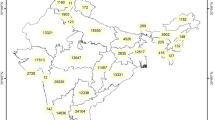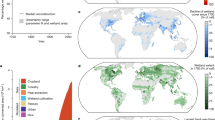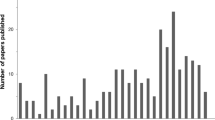Abstract
Wetlands are among the most productive ecosystems on the planet and they are being subjected to heavy pressure by human activities. Changes in wetlands due to human impacts have increased, and it is estimated that half of the global wetland area has been lost during the last century. Documented cases of wetland transformation confirm the trend in Colombia. We used official nationwide wetland maps and land cover maps to quantify the areas within wetlands with non-natural land cover, such as pasture or cropland; and we used spatial analysis tools to identify the regions of the country where greater wetland transformations have occurred. Approximately 24 % of the area of mapped wetlands has land cover types related to intensive rural land use. Pastures and other types of land cover related to raising cattle account for 4 million ha and cover 50 % of the transformed wetland areas. There are 14 different regions where wetland loss is the most critical in Colombia. We analyzed the wetland areas related to raising cattle, agriculture, deforestation, and mining separately and found different spatial patterns for each activity. Hence, different conservation policies should be implemented across the country to account for spatial differences in the drivers of change.




Similar content being viewed by others
References
Anselin L (1995) Local indicators of spatial association - LISA. Geographical Analysis 27(2):93–115
Anselin L (2003) Spatial externalities, spatial multipliers, and spatial econometrics. International Regional Science Review 26(2):153–166. doi:10.1177/0160017602250972
Anselin L, Syabri I, Kho Y (2006) GeoDa: An introduction to spatial data analysis. Geographical Analysis 38(1):5–22
Beach T, Luzzadder-Beach S (2012) Pre-Columbian people and the wetlands in Central and South America. In: Menotti F, O’Sullivan A (eds) The Oxford Handbook of Wetland Archaeology (pp. 83–103). Oxford University Press. doi:10.1093/oxfordhb/9780199573493.013.0007
Cabrera E, Vargas DM, Galindo G, García MC, Ordoñez MF, Vergara LK, Pacheco AM, Rubiano JC, y Giraldo P (2011) Memoria técnica de la cuantificación de la deforestación histórica nacional – escalas gruesa y fina. Instituto de Hidrología, Meteorología, y Estudios Ambientales-IDEAM-. Bogotá D.C., Colombia. 106 p
Camargo A (2012) Landscapes of Fear: Water Grabbing, Wetland Conservation, and the Violence of Property in Colombia. En International Conference on Global Land Grabbing II (p. 28). Land Deals Politics Initiative
Chen M, Liu J (2015) Historical trends of wetland areas in the agriculture and pasture interlaced zone: A case study of the Huangqihai Lake Basin in northern China. Ecological Modelling. doi:10.1016/j.ecolmodel.2014.12.012
Chuvieco E (1995) Fundamentos de Teledetección Espacial, 2nd edn, Madrid, 454 p
Clare S, Creed IF (2013) Tracking wetland loss to improve evidence-based wetland policy learning and decision making. Wetlands Ecology and Management 22(3):235–245. doi:10.1007/s11273-013-9326-2
Comisión Económica para América Latina y el Caribe - Cepal (2012) Valoración de daños y pérdidas. Ola invernal en Colombia, 2010–2011. Bogotá
Currie L (1950) The Basis of a Development Program for Colombia. International Fund for Reconstruction and Development. Washington D.C. 685 p
Etter A, McAlpine C, Wilson K, Phinn S, Possingham H (2006) Regional patterns of agricultural land use and deforestation in Colombia. Agriculture, Ecology and Environment 114:369–386
Flórez-Ayala C, Estupiñán-Suárez LM, Rojas S, Aponte C, Quiñones M, Acevedo O, Jaramillo U (2016) Identificación espacial de los sistemas de humedales continentales de Colombia. Biota Colombiana, in press
Garzón Yepes NV, Gutiérrez Camargo JC (2013) Deterioro de humedales en el Magdalena medio: Un llamado para su conservación. Bogota D.C.: Fundación Alma - Instituto de Investigación de Recursos Biológicos Alexander von Humboldt. 145 pp
Getis A, Ord JK (1992) The analysis of spatial association by distance statistics. Geographical Analysis 355(24):189–206
Humboldt Institute (2015) Mapa de Humedales de continentales de Colombia. In: Instituto de Investigación de Recursos Biológicos Alexander von Humboldt. Fondo Adaptación. Convenio 13–014 (FA 005 de 2013), Bogotá D. C.
Hussien Aragaw K (2014) Assessment of spatio-temporal changes of wetlands using GIS and RS techniques in Dawa Chefa Area in the Northern Central Ethiopian Highlands. Mekelle University, Dissertation
IDEAM (2010) Leyenda nacional de coberturas de la tierra. Metodología CORINE Land Cover adaptada para Colombia. Escala 1:100.000. Bogota D.C.: Instituto de Hidrología, Meteorología y Estudios Ambientales
IDEAM (2012) Mapa de Coberturas de la Tierra. Metodología Corine Land Cover Adaptada para Colombia. Escala 1:100.000, Periodo 2005–2009. Bogota: Instituto de Hidrología, Meteorología y Estudios Ambientales
IDEAM, SARVISION, I. Humboldt (2014) Mapa Nacional de frecuencias de inundación 2007–2011. Bogota D.C., Colombia: IDEAM, SARVISION, I. Humboldt
IGAC (2014a) Cartografía básica de Colombia, GDB, Escala 1:100.000. Bogota D.C., Colombia: Instituto Geográfico Agustín Codazzi
IGAC (2014b) Mapa de Geopedología, Escala 1:100.000. Bogota D.C., Colombia: Instituto Geográfico Agustín Codazzi
Jackson CR, Thompson JA, Kolka RK (2014) Wetland soils, hydrology, and geomorphology. In: Batzer D, Sharitz R (eds) Ecology of freshwater and estuarine wetlands, 2nd edn. University of California Press, Berkeley, pp. 23–60
Jiang W, Wang W, Chen Y, Liu J, Tang H, Hou P, Yang Y (2012) Quantifying driving forces of urban wetlands change in Beijing City. Journal of Geographical Sciences 22(2):301–314. doi:10.1007/s11442-012-0928-z
Kayastha N, Thomas V, Galbraith J, Banskota A (2012) Monitoring wetland change using inter-annual landsat time-series data. Wetlands 32(6):1149–1162
Klemas V (2013) Remote sensing of emergent and submerged wetlands: an overview. International Journal of Remote Sensing 34(18):6286–6320. doi:10.1080/01431161.2013.800656
Li L, Vrieling A, Skidmore A, Wang T, Muñoz A-R, Turak E (2015) Evaluation of MODIS spectral indices for monitoring hydrological dynamics of a small, seasonally-flooded wetland in Southern Spain. Wetlands 35(5):851–864. doi:10.1007/s13157–015–0676-9
Márquez G (2001) De la abundancia a la escasez: La transformación de ecosistemas en Colombia. In: Palacios G (ed) La Naturaleza en Disputa. Universidad Nacional de Colombia. UNIBIBLOS, Bogotá
McCoy RM (2005) Field methods in remote sensing. New York: The Guilford Press
Meidinger DV (2003) Protocol for accuracy assessment of ecosystem maps. Res Br, BC Min For, Victoria, BC Technical report 11:23 p
Niu Z, Zhang H, Wang X, Yao W, Zhou D, Zhao K, Gong P (2012) Mapping wetland changes in China between 1978 and 2008. Chinese Science Bulletin 57(22):2813–2823. doi:10.1007/s11434-012-5093-3
Ottinger M, Kuenzer C, Liu G, Wang S, Dech S (2013) Monitoring land cover dynamics in the Yellow River Delta from 1995 to 2010 based on Landsat 5 TM. Applied Geography 44:53–68. doi:10.1016/j.apgeog.2013.07.003
Parzen E (1962) On estimation of a probability density function and mode. The Annals of Mathematical Statistics 33(3):1065–1076. doi:10.1214/aoms/1177704472
QGIS Development Team (2015). QGIS 2.8 Wien. QGIS Geographic Informatio System. Open Source Geospatial Fundation Project. Retrieved from http://www.qgis.org
Ramachandra, T. V., Rajinikanth, R., & Ranjini, V. G. (2005). Economic valuation of wetlands. Journal of Environmental Biology
Ramírez F, Davenport TL, Kallarackal J (2013) Bogotá’s Urban Wetlands: Environmental Issues. In: Lavigne G, Cote C (eds) Colombia: Social, Economic and Environmental Issues (pp. 1–80). Nova Science Publishers. Retrieved from http://www.ncbi.nlm.nih.gov/pubmed/15003161
Rebelo LM, Finlayson CM, Nagabhatla N (2009) Remote sensing and GIS for wetland inventory, mapping and change analysis. Journal of Environmental Management 90(7):2144–2153. doi:10.1016/j.jenvman.2007.06.027
Restrepo C, Naranjo LG (1987) Recuento histórico de la disminución de humedales y la desparación de aves acuáticas en el Valle del Cauca, Colombia. In: Alvarez H, Kattan G, Murcia C (eds) Memorias III Congreso de Ornitologia Neotropical: (pp. 43–5). Cali: ICBP- USFWS-SVO
Ricaurte LF, Gutiérrez J, Borja SM, Cepeda-Valencia J, Arroyave LJ, Olaya-Rodríguez MH, Lara D (2014) Evaluación y mapeo de los impulsores de cambio directos sobre los humedales a escala 1:100.000 en las cuencas priorizadas por el Fondo Adaptación. Technical Report, Bogota
Rodríguez Eraso N, Armenteras-Pascual D, Alumbreros JR (2013) Land use and land cover change in the Colombian Andes: dynamics and future scenarios. Journal of Land Use Science 8(2):154–174. doi:10.1080/1747423X.2011.650228
Rodríguez N, Armenteras D, Retana J (2015) National ecosystems services priorities for planning carbon and water resource management in Colombia. Land Use Policy 42:609–618. doi:10.1016/j.landusepol.2014.09.013
Rosenblatt M (1956) Remarks on some nonparametric estimates of a density function. The Annals of Mathematical Statistics 27(3):832–837. doi:10.1214/aoms/1177728190
Ross PM, Adam P (2013) Climate change and intertidal wetlands. Biology 2(1):445–480
Scholte SSK, Todorova M, van Teeffelen AJA, Verburg PH (2016) Public support for wetland restoration: What is the link with ecosystem service values? Wetlands 36:467–481. doi:10.1007/s13157–016–0755-6
SIAC (2015) Mapa de Coberturas Nacionales. Retrieved 29th April 2015 from https://www.siac.gov.co/contenido/contenido.aspx?catID=905&conID=1450
Song G, Fu C, Yong E (2011) The analysis of ecosystem service value’s change in Yueqing Bay wetland based on RS and GIS. Progress in Environmental Science 11:1365–1370. doi:10.1016/j.proenv.2011.12.205
Turner RK, Van den Bergh JCJM, Soderqvist T, Barendregt A, Van der Straaten J, Maltby E, Van Ierland EC (2000) Ecological-economic analysis of wetlands: Scientific integration for management and policy. Ecological Economics 35(1):7–23. doi:10.1016/S0921–8009(00)00164–6
Yu Y, Suo A, Jiang N (2011) Response of ecosystem service to landscape change in Panjin coastal wetland. Procedia Earth and Planetary Science 2:340–345. doi:10.1016/j.proeps.2011.09.053
Yuan H, Zhang R (2010) Changes in wetland landscape patterns on Yinchuan Plain, China. International Journal of Sustainable Development & World Ecology 17(3):236–243. doi:10.1080/13504501003729614
Zedler JB, Kercher S (2005) Wetland resources: status, trends, ecosystem services, and restorability. Annual Review of Environment and Resources 30(1):39–74. doi:10.1146/annurev.energy.30.050504.144248
Acknowledgements
This research was undertaken as part of the project “Ecosistemas Estrategicos Páramos y Humedales” funded by Fondo Adaptacion del Ministerio de Hacienda, and conducted by Alexander von Humboldt Institute for Research on Biological Resources (Convention no 008 of 2013). We are grateful to the “Paramos y Humedales” coordinators, team, and the director at Humboldt Institute. Our acknowledge to Ministry of Environment and Sustainable Development of Colombia MADS, IDEAM, JAXA, K&C, Wageningen University and SarVision that collaborated generating inputs used on this study.
Author information
Authors and Affiliations
Corresponding author
Rights and permissions
About this article
Cite this article
Patino, J.E., Estupinan-Suarez, L.M. Hotspots of Wetland Area Loss in Colombia. Wetlands 36, 935–943 (2016). https://doi.org/10.1007/s13157-016-0806-z
Received:
Accepted:
Published:
Issue Date:
DOI: https://doi.org/10.1007/s13157-016-0806-z




